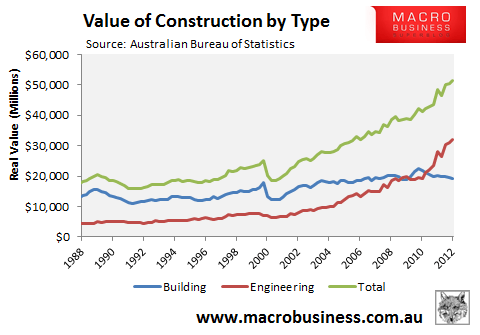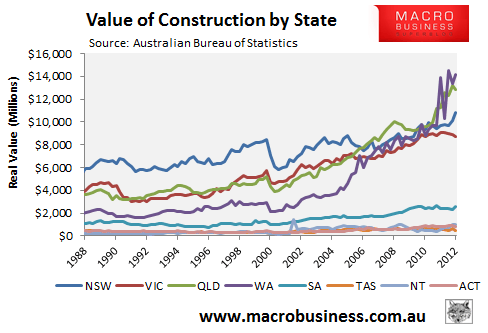The ABS released Construction Work Done for the September quarter this morning, which is a key driver of Australia’s business investment led GDP. Here are the key figures:
SEPTEMBER KEY FIGURES
|
Sep qtr 12 |
Jun qtr 12 to Sep qtr 12 |
Sep qtr 11 to Sep qtr 12 | ||
|
$m |
% change |
% change | ||
|
TREND ESTIMATES(a) | ||||
|
| ||||
| Value of work done | ||||
| Building |
19 332.7 |
-0.9 |
-3.3 | |
| Residential |
11 147.5 |
-0.9 |
-5.0 | |
| Non-residential |
8 188.2 |
-0.8 |
-0.9 | |
| Engineering |
32 241.6 |
4.4 |
22.4 | |
| Total construction |
51 681.8 |
2.6 |
11.6 | |
|
SEASONALLY ADJUSTED ESTIMATES(a) | ||||
|
| ||||
| Value of work done | ||||
| Building |
19 257.9 |
-1.6 |
-4.9 | |
| Residential |
11 221.9 |
0.6 |
-3.7 | |
| Non-residential |
8 036.0 |
-4.5 |
-6.4 | |
| Engineering |
32 040.1 |
3.8 |
13.9 | |
| Total construction |
51 298.0 |
1.7 |
6.0 | |
No real surprises here. The mining boom continues to power with engineering work done up 3.8% in the quarter and 13.9% year on year. Until recently, this was being offset by declines in residential and other construction, but this release shows some improvement in residential, although still down -3.7% on the year, the quarter on quarter number improved 0.6%. Other construction continues to struggle. Some hope for the RBA’s growth hand-off plan then.
Westpac sees the following internals:
Private infrastructure work, which is lumpy from quarter to quarter, rose 7.8% in the quarter, following an increase of 1.1% in Q2 (revised up from 0.2%).
Private new residential building activity increased by 0.9%, following five quarters of decline. This is the start of an upswing, although the strength of the cycle remains uncertain.
Private renovation work fell once again, down 2.0%, the fourth consecutive fall. This is an indication that consumers have been relatively cautious over this time.
Private non-residential building activity slipped, down 3.0%. This follows rises in four of the last five quarters. The level of work in this segment remains around historic lows, as a share of GDP.
Public construction pulled back as we anticipated, but the correction was sharper than we allowed for, with a fall of 7.3% (vs f/c -2.5%). This follows a 1.9% rise in Q2, a result boosted by a “burst” of activity prior to the end of the 2011/12 financial year.
The total of these, 1.7% quarter on quarter was below consensus of 2% but is still very strong. Still, this is one input into a GDP disappointment.
A couple of charts for ya:



